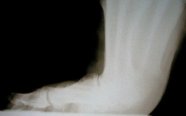Painful joints can occur is any area of the foot or ankle. Most often, the cause is due to a previous acute injury which can later manifest into chronic joint damage and pain. Pain can be associated with stiffness, but not in all cases. When one has pain in the joint this usually indicates that the joint cartilage is worn down to bare bone or the bone to bone pressure is extraordinarily high (bone end pounding on bone end).
The the most common areas in the foot or ankle are the Great Toe joints, 2nd and 3rd toe joints, the calcaneal-cuboid joint and the ankle.
Pain in these joints can cause severe disability if not treated accurately and promptly.
Great Toe Joint Pain
Before | After | Update: range of motion on big left toe has increased 100% and there is no pain at all. I have returned to my jogging regimen of 7 to 9 miles, 3 to 4 times per week, which was impossible for me to do before the surgery on 12/17/98. Thanks to Dr. Lee I am 100% mobile again! |
Stiffness of the great toe joint is often a sign of degeneration of the joint cartilage which occurs gradually with time. Pain can be associated with stiffness, but not in all cases. When one has pain in the joint this usually indicates that the joint cartilage is worn down to bare bone or the bone to bone pressure is traumatically high (bone end pounding on bone end).
Conservative Treatments
Because this condition arises from an abnormal mechanical function of the great toe joint initial evaluation and treatment should always include a thorough examination and understanding of the specific mechanical shortcomings your toe function. Based on these findings, treatments may include injections, oral anti-inflammatories (like Advil or Celebrex), physical therapy, custom orthotics (prescription arch inserts), rest, activity changes, and shoe gear changes.
If these regimens fail then surgery can be a excellent choice for returning you back to activities.
Surgical Treatments
There are a variety of excellent procedures for the correction of Hallux Limitus. The specific technique used for your condition will depend on the specific examination of the joint characteristics. Some individuals may have be candidates for joint reconstruction and some may require joint replacement. Often times the decision for reconstruction versus replacement is an intra-operative (decided during the time of surgery) decision since x-rays,CT scans or MRI's don't reveal the precise condition of the cartilage.
Dr. Lee specializes in reconstructive joint surgery of the great toe. For those patients where reconstruction is not possible Arthrosurface's Hemicap is recommended over traditional techniques such as joint fusion.
 The Arthrosurface® HemiCAP® system is a surgical method for the treatment of localized cartilage lesions and defects in the major joints . This system is comprised of three elements; a three-dimensional mapping technology, a set of instruments to map and prepare the damaged area and a cobalt-chrome and titanium implant. The system precisely aligns the surface of the implant to the contours of the patient's articular cartilage surface, thus filling the defect and restoring a smooth and continuous articular surface. The HemiCAP® system has been developed so that it can be utilized via minimally disruptive surgical techniques.
The Arthrosurface® HemiCAP® system is a surgical method for the treatment of localized cartilage lesions and defects in the major joints . This system is comprised of three elements; a three-dimensional mapping technology, a set of instruments to map and prepare the damaged area and a cobalt-chrome and titanium implant. The system precisely aligns the surface of the implant to the contours of the patient's articular cartilage surface, thus filling the defect and restoring a smooth and continuous articular surface. The HemiCAP® system has been developed so that it can be utilized via minimally disruptive surgical techniques.
The HemiCAP offers several distinct advantages over other implants or fusion procedures:
- Faster recovery and healing
- Maintenance of joint motion
- Minimal joint destruction to implant the device leaving other options available should the implant fail
- Anatomic range of motion (Great toe will flex and glide rather than pivot)
Request Appointment Online:



